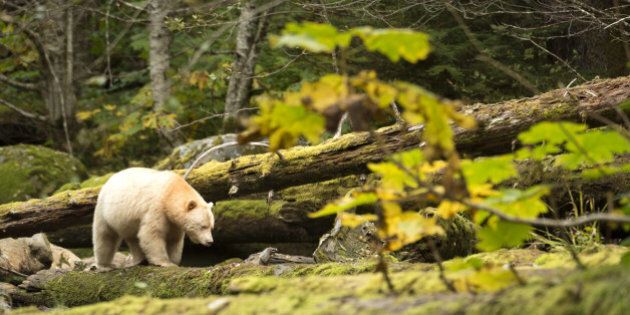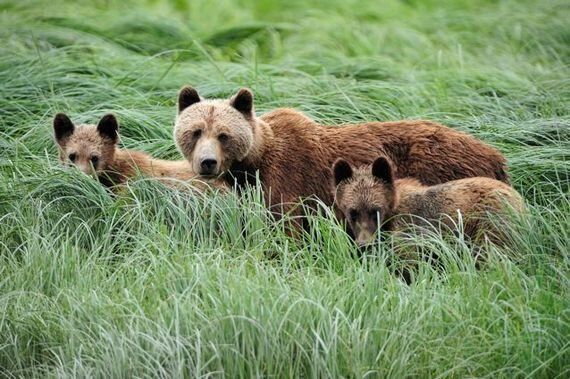

Glendale grizzlies, British Columbia (Photo by Klaus Gretzmacher)
First Nations, environmentalists, industry and governments are all celebrating the recent announcement of the 2016 Great Bear Rainforest Agreement. This sweeping, globally-significant agreement marks more than 20 years of efforts to redefine land use in the 8.8-million-acre (3.6-million-hectare) Great Bear Rainforest, which encompasses the BC coast from Campbell River to Stewart.
The Nature Conservancy of Canada (NCC) congratulates all those who worked for years to achieve this agreement. The Great Bear Rainforest is an area in which we have long been engaged, both with our expertise in conservation science and planning and with our campaigns to secure private lands, such as the Gullchucks Estuary on Denny Island and our assembly of conservation lands in Rivers Inlet.
A long road to consensus
The Great Bear Rainforest Agreement was negotiated by such a diverse group of interests that at times consensus seemed all but impossible. Independent conservation science played a key role in bringing these seemingly incompatible interests to the same table. The science helped them find common ground when discussing how to manage and relate to this very special place.
In 2002, after years of fractious environmental campaigns, international boycotts and an inability to find a starting point for negotiation, an independent multidisciplinary advisory group was established: The Coast Information Team (CIT). The group was tasked with providing independent information on the central and north coasts of British Columbia and Haida Gwaii, including the Great Bear Rainforest, to help inform the negotiations that aimed to reach consensus on how the lands were to be managed.
The Coast Information Team
The Nature Conservancy of Canada, along with internationally renowned conservation biologist Reed Noss, was entrusted by the Provincial Government of British Columbia, First Nations, environmental groups, the forest industry and communities to lead the project team. NCC was recognized as a neutral and honest broker of information that could produce credible science. NCC's science staff, along with experts from other organizations, governments and First Nations, spent 18 months coordinating the massive undertaking.
"We pulled together all these brilliant minds, lots of PhDs, biologists, foresters and others. We had access to any government data set we needed, and expert staff," remembers Pierre Iachetti, a former NCC staffer who coordinated the peer review process and managed the data collection for the ecosystem spatial analysis component of the study:
"Even the forest companies gave us access to their forest cover data, which was a huge coup. They didn't trust the advocacy groups with that data, so we were the first to get it. The Nature Conservancy of Canada's reputation opened many doors."
The resulting reports, analysis and guidelines incorporated the best available scientific, technical, traditional and local knowledge on the Great Bear Rainforest. The goal was to illuminate--objectively--the ecological, cultural and economic landscapes of this coastal region.
A controversial finding
When the CIT published its reports, the group's ecosystem modelling and analysis suggested that 70 percent of the Great Bear Rainforest would need to be protected in order to retain the integrity of the overall system. At the time, the International Union for the Conservation of Nature was calling for the protection of 12 per cent of the world's various ecosystems.
"I remember it being controversial when it got out to the public that we were saying we need to protect 70 percent of the Great Bear. That was seen as outrageous," recalls Pierre. "But we stuck to it. We said, this is what our data and our analyses tell us. But now the final solution is 85 percent, which is a testament to the negotiators."
Recommendations that changed the world
The CIT also developed an approach to ecosystem-based management that incorporated both ecosystem information and human well-being. The group published a guidebook that continues to inform the implementation of ecosystem-based management on the BC coast.
"The big thing about what the CIT produced was that everybody took our results and used them for their own purposes," says Pierre. "The advocacy groups put our maps in the media to pressure industry and the government, saying: These independent scientists that you paid money for, that you trusted, said to protect a minimum of 70 per cent."
Those maps, analyses and recommendations were also spread across the negotiating tables as multi-stakeholder planning groups developed practical solutions for land use and natural resource management issues -- leading to the crown jewel of solutions in the Great Bear Rainforest Agreements. The CIT's analyses helped to define the boundaries of the Great Bear conservancies that were established in 2006, and underpinned the current agreement that is being celebrated by people on all sides of the land-use issue.
"The Coast Information Team absolutely laid the foundation for everybody to achieve what was achieved. If we hadn't done the planning, my guess is that 25 percent or 30 percent protection would have been considered a success. We really raised the bar," says Pierre. "I'm proud of the role NCC played. The interesting thing is to see how everyone -- industry, government, environmentalists and First Nations -- came together to find a solution. It was really ugly in the beginning, but the stakeholders have been working together for 10-15 years now and there's real respect and camaraderie between them all."
____________
Pierre Iachetti, PAg, MCIP, RPP, worked for the Nature Conservancy of Canada as the BC conservation planner and then director of conservation science and planning from 2001 to 2010. Currently he is the executive director of the College of Applied Biology.
Article written by Lesley Marian Neilson, communications manager with the Nature Conservancy of Canada in the BC Region. This article was first published on the Nature Conservancy of Canada's website.